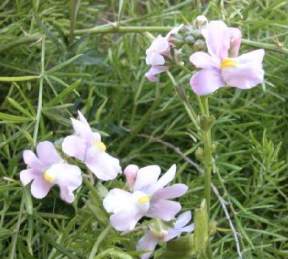Nemesia fruticans
Nemesia fruticans (Thunb.) Benth.
Family: Scrophulariaceae
Common names: Cape snapdragon, mauve nemesia (Eng.) leeubekkie, maagpynblommetjie, witleeubekkie, wildeleeubekkie (Afr.)
Introduction
This dainty, long-flowering perennial is a charming addition to the summer garden, but what is commonly sold in nurseries as Nemesia fruticans may be due for a name change.

Description
Description
Nemesia fruticans is a perennial that is used mostly as an annual. It grows up to 600 mm in height. It has many slender erect stems which branch freely, emerging from a woody taproot. Stems have numerous, narrow, serrated leaves which are denser near the base of the stem. The leaves are fresh green and shiny. The stems grow lanky as more and more flowers develop at the tips.

The flowers resemble little snapdragon flowers, with two lips and a spur. They are dusty-pink or mauve or even whiter in colour and decorated with bright yellow protuberances in the throat. The mauve nemesia flowers mostly at the beginning of spring (September-October), but the flowering season can extend through summer to autumn. The seeds are produced in flat capsules which are dry and whitish to yellow-brown in colour.
Distribution and habitat
Distribution description
Nemesia fruticans occurs naturally throughout the summer rainfall grassland areas of South Africa where it grows mostly in among rocks. Like many other grassland perennials it has a woody taproot that helps it survive fires and winter frost.
Derivation of name and historical aspects
History
The name Nemesia is derived from the name Nemesion, the generic name of a similar plant. The name fruticans is derived from the Latin word frutex which means a shrubby plant. There is some debate, however, about the identity of the plant commonly cultivated under this name, and this genus is under revision at present.
The genus Nemesia is found only in South Africa and has about seventy species. The family Scrophulariaceae is the large snapdragon family which consists of about 5 100 species worldwide. Amongst them, the foxgloves or Digitalis are known to contain certain drug chemicals. In South Africa there are 79 genera of the family Scrophulariaceae.
Uses
Use
Nemesia fruticans is used mostly as a flowering bedding plant and as an ornamental pot plant. Various colour forms are available from specialist nurseries.
Growing Nemesia fruticans
Grow
It is best propagated by seed sown in spring for summer flowering. It can also be propagated by means of cuttings. Cuttings are best taken in spring when regrowth commences and active root formation takes place. Special colour forms are best propagated from cuttings.
It prefers well-drained soil, enriched with compost. It prefers to be planted in a sunny position. It can be treated as an annual and will self-seed if plants have been allowed to set seed before removal. Alternatively it can be treated as a perennial and cut back after flowering each year, or in early spring. It is frost tolerant. Although the upper growth is damaged by frost, the plant will resprout from the taproot.
References
- ELIOVSON, S. 1984. Wild flowers of southern Africa. Botanical Research Institute, Pretoria.
- GERMISHUIZEN, G. 1997. Wild flowers of northern South Africa. Fernwood Press, Cape Town.
- JACKSON, B. D. 1971. A glossary of botanic terms. Gerald Duckworth, London.
- ONDERSTALL, J. 1996. Sappi wild flower guide: Mpumalanga & Northern Province. Dynamic ad, Nelspruit.
- SMITHIES, S. Pers.comm. National Botanical Institute, Pretoria.
Credits
Moeketsi Samson Letsela
Witwatersrand National Botanical Garden
With additions by Yvonne Reynolds
July 2002
Plant Attributes:
Plant Type: Bi/Annual, Perennial
SA Distribution: Eastern Cape, Free State, Gauteng, KwaZulu-Natal, Limpopo, Mpumalanga, North West, Northern Cape, Western Cape
Soil type: Sandy, Loam
Flowering season: Spring, Early Summer
PH: Acid, Neutral
Flower colour: Pink, Mauve/Lilac
Aspect: Full Sun
Gardening skill: Easy
Special Features:
Horticultural zones











Rate this article
Article well written and informative
Rate this plant
Is this an interesting plant?
Login to add your Comment
Back to topNot registered yet? Click here to register.